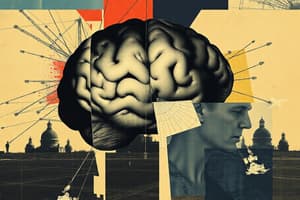Podcast
Questions and Answers
What type of perceptual task shows improvement with practice, as demonstrated by McKee and Westheimer in 1978?
What type of perceptual task shows improvement with practice, as demonstrated by McKee and Westheimer in 1978?
- Orientation discrimination
- Vernier discrimination (correct)
- Face discrimination
- Stereoscopic depth discrimination
According to Ramachandran and Braddick's 1973 study, what type of perceptual task shows improvement with practice?
According to Ramachandran and Braddick's 1973 study, what type of perceptual task shows improvement with practice?
- Stereoscopic depth discrimination (correct)
- Vernier discrimination
- Face recognition
- Orientation discrimination
What is the main difference between the findings of perceptual learning in simple and complex tasks?
What is the main difference between the findings of perceptual learning in simple and complex tasks?
- Simple tasks show less learning than complex tasks (correct)
- There is no difference in learning between simple and complex tasks
- Complex tasks show more learning than simple tasks
- Simple tasks show more learning than complex tasks
What type of strategy was initially thought to contribute to improvements in perceptual tasks in the 1970s and 1980s?
What type of strategy was initially thought to contribute to improvements in perceptual tasks in the 1970s and 1980s?
What is the term used to describe the minimum difference in stimulation that an observer can detect?
What is the term used to describe the minimum difference in stimulation that an observer can detect?
What type of noise was found to show more learning in perceptual tasks, according to Fine and Jacobs in 2002?
What type of noise was found to show more learning in perceptual tasks, according to Fine and Jacobs in 2002?
What is the primary difference between tasks represented by orange and yellow versus purple and pink?
What is the primary difference between tasks represented by orange and yellow versus purple and pink?
What type of tasks showed more learning?
What type of tasks showed more learning?
What is the relationship between initial performance levels and amount of learning?
What is the relationship between initial performance levels and amount of learning?
What was the primary finding of Fahle and Henke-Fahle's (1996) study?
What was the primary finding of Fahle and Henke-Fahle's (1996) study?
What was the range of thresholds for the subjects in Fahle and Henke-Fahle's (1996) study?
What was the range of thresholds for the subjects in Fahle and Henke-Fahle's (1996) study?
What did Astle et al. (2012) test in their study?
What did Astle et al. (2012) test in their study?
What was the purpose of equating Vernier discrimination performance in Astle et al.'s (2012) study?
What was the purpose of equating Vernier discrimination performance in Astle et al.'s (2012) study?
What is the effect of increasing eccentricity on Vernier discrimination performance?
What is the effect of increasing eccentricity on Vernier discrimination performance?
Study Notes
Perceptual Learning on Simple Tasks
- Vernier discrimination improves with practice, as shown by McKee and Westheimer (1978), where the goal is to detect the smallest offset between two bars.
- Orientation discrimination also improves with practice, as demonstrated by Vogels and Orban (1985).
- Stereoscopic depth discrimination improves with practice, as shown by Ramachandran and Braddick (1973), where the goal is to determine the location of a disc in relation to a background.
Perceptual Learning on Complex Tasks
- Increasing complexity in stimuli leads to more perceptual learning, as shown by Fine and Jacobs (2002).
- Tasks using stimuli with external noise show more learning than low-level tasks.
- Complex tasks that require discriminations along multiple perceptual dimensions show more learning.
- Examples of complex tasks include face discrimination, which involves multiple dimensions such as shape, contrast, and more.
Amount of Learning and Initial Performance Levels
- The amount of learning is inversely related to initial performance levels, as shown by Fahle and Henke-Fahle (1996).
- Poorer initial performance on a Vernier discrimination task leads to more learning on the task.
- The change in threshold is higher if you start at a poorer performance level.
Factors Limiting Learning
- Astle et al. (2012) tested whether the same factors that limit performance on a task also limit learning on the same task.
- They manipulated Vernier discrimination performance by equating thresholds across individuals and conditions, and tested at different eccentricities.
- The results showed that the same factors that limit performance also limit learning.
Studying That Suits You
Use AI to generate personalized quizzes and flashcards to suit your learning preferences.
Description
This quiz covers the improvement of performance on simple perceptual tasks with practice, including Vernier discrimination and orientation discrimination. It explores the learning process and discrimination threshold in perceptual tasks.




